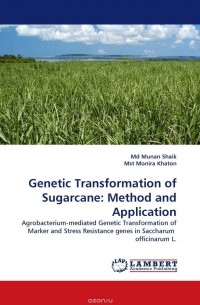Mst Monira Khaton — новинки
-
Genetic Transformation of Sugarcane: Method and Application Md Munan Shaik, Mst Monira Khaton
ISBN: 9783844380187 Год издания: 2011 Издательство: LAP LAMBERT Academic Publishing Язык: Английский Traditional plant breeding techniques, together with chemical, biotechnological approaches, have been extensively used to increase crop yields which are more productive and resistant to diseases and pathogens. However, conventional breeding is a lengthy process. Incorporation of desired gene(s) from foreign source is the prime needs to overcome the bottleneck. Genetic transformation of sugarcane deserve the due research attention for the purpose. Agrobacterium- mediated genetic transformation in differents sugarcane varieties and regeneration of plantlets from transformed explants were discussed. The transformation efficiency in callus, organogenic pre-treated callus and meristematic spindle leaf segments at different infection time by five Agrobacterium strains containing GUS marker gene and Stress resistance genes (CIPK, CBL and Gly1) were explained. PCR based confirmation of GUS reporter gene was done using DNA isolated from plantlets regenerated from transformed explants. Phenotypic expression of resistance genes also explained with the different regeneration medium containing selective stresses. -
STERILE INSECT TECHNIQUE TO CONTROL DESTRUCTIVE INSECT PEST MELON FLY Md Munan Shaik, Mst Monira Khaton
ISBN: 9783844390537 Год издания: 2011 Издательство: LAP LAMBERT Academic Publishing Язык: Английский The Sterile Insect Technique (SIT) has proved to be a well established method of controlling several key pests of agricultural importance. SIT depends upon introducing a high proportion of sterile mating in a natural population that reduces reproduction to a level below population maintenance. Therefore, the production of insects, in sufficient number and of adequate quality to achieve this aim, is one of the principal requirements for the success of the technique. Melon fly (B. cucurbitae) is a major threat to cucurbits. The flies are widely distributed and occur in all countries of the world. Cucurbit vegetables thus suffers considerable economic losses every year. The SIT is increasingly applied with the objective to reduce losses and pesticide use rather than fruit fly eradication in many countries. This research traced the opportunities of controlling destructive insect pest of agricultural importance by eco-friendly way with SIT. Extensive reports were made in sterility dose, pupal duration and the ratios of irradiated males of B. cucurbitae could be used as a preliminary basis for the field applications of SIT to suppress the wild population of B. cucurbitae. -
Efficient DNA Purification Protocol for Fingerprinting of Sugarcane Md Munan Shaik, Mst Monira Khaton, RMS Shahnawas
ISBN: 9783844394627 Год издания: 2011 Издательство: LAP LAMBERT Academic Publishing Язык: Английский Sugarcane (Saccharum officinarum L.) is one of the leading crops in the world. Molecular characterization and molecular marker assisted selection in sugarcane breeding might be a tool for improvement of this crop can assist in increasing sugar production. Like many other plant species, sugarcane tissues contain high levels of polysaccharides and polyphenolic compounds, which present a major contamination problem during DNA purification. High-concentrations of polysaccharides, which co-purify with DNA in normal phenol-chloroform extractions and polyphenols covalently bind to DNA making it useless for most research applications. An rapid, efficient and easy DNA purification procedure for sugarcane is an urgent need in genome mapping and marker assisted selection (MAS) programs. In the present investigation an efficient and easy method was developed for isolation of high quality DNA from meristem cylinder in sugarcane. With the method developed high quality DNA isolation was possible without use of liquid nitrogen, tissue homogenizer and using a simple micro-centrifuge. Isolated DNA well performed for PCR amplification and DNA Fingerprinting using RAPD markers.



